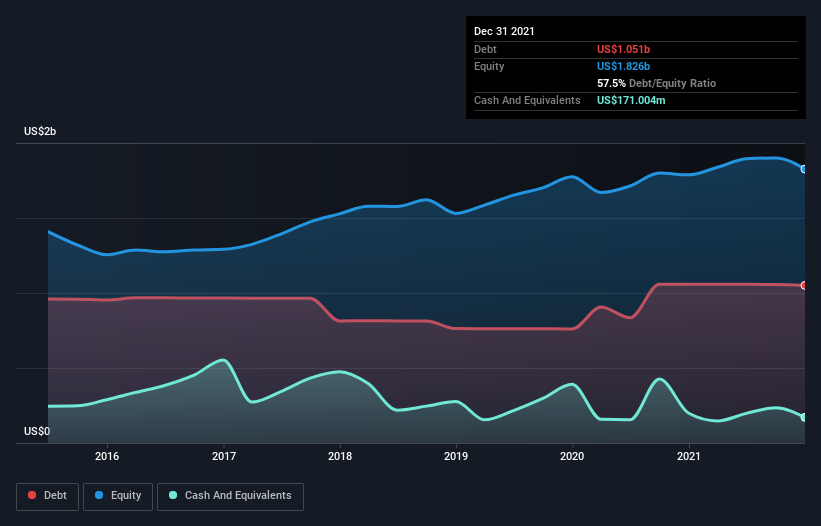- United States
- /
- Aerospace & Defense
- /
- NYSE:CW
We Think Curtiss-Wright (NYSE:CW) Can Stay On Top Of Its Debt
The external fund manager backed by Berkshire Hathaway's Charlie Munger, Li Lu, makes no bones about it when he says 'The biggest investment risk is not the volatility of prices, but whether you will suffer a permanent loss of capital.' When we think about how risky a company is, we always like to look at its use of debt, since debt overload can lead to ruin. We can see that Curtiss-Wright Corporation (NYSE:CW) does use debt in its business. But should shareholders be worried about its use of debt?
When Is Debt A Problem?
Debt is a tool to help businesses grow, but if a business is incapable of paying off its lenders, then it exists at their mercy. Ultimately, if the company can't fulfill its legal obligations to repay debt, shareholders could walk away with nothing. However, a more common (but still painful) scenario is that it has to raise new equity capital at a low price, thus permanently diluting shareholders. By replacing dilution, though, debt can be an extremely good tool for businesses that need capital to invest in growth at high rates of return. When we examine debt levels, we first consider both cash and debt levels, together.
Check out our latest analysis for Curtiss-Wright
What Is Curtiss-Wright's Debt?
As you can see below, Curtiss-Wright had US$1.05b of debt, at December 2021, which is about the same as the year before. You can click the chart for greater detail. However, it also had US$171.0m in cash, and so its net debt is US$879.6m.

A Look At Curtiss-Wright's Liabilities
The latest balance sheet data shows that Curtiss-Wright had liabilities of US$734.9m due within a year, and liabilities of US$1.54b falling due after that. Offsetting these obligations, it had cash of US$171.0m as well as receivables valued at US$647.1m due within 12 months. So its liabilities outweigh the sum of its cash and (near-term) receivables by US$1.46b.
While this might seem like a lot, it is not so bad since Curtiss-Wright has a market capitalization of US$5.83b, and so it could probably strengthen its balance sheet by raising capital if it needed to. However, it is still worthwhile taking a close look at its ability to pay off debt.
We measure a company's debt load relative to its earnings power by looking at its net debt divided by its earnings before interest, tax, depreciation, and amortization (EBITDA) and by calculating how easily its earnings before interest and tax (EBIT) cover its interest expense (interest cover). Thus we consider debt relative to earnings both with and without depreciation and amortization expenses.
Curtiss-Wright's net debt to EBITDA ratio of about 1.7 suggests only moderate use of debt. And its strong interest cover of 10.3 times, makes us even more comfortable. Also good is that Curtiss-Wright grew its EBIT at 11% over the last year, further increasing its ability to manage debt. There's no doubt that we learn most about debt from the balance sheet. But it is future earnings, more than anything, that will determine Curtiss-Wright's ability to maintain a healthy balance sheet going forward. So if you're focused on the future you can check out this free report showing analyst profit forecasts.
But our final consideration is also important, because a company cannot pay debt with paper profits; it needs cold hard cash. So we always check how much of that EBIT is translated into free cash flow. During the last three years, Curtiss-Wright produced sturdy free cash flow equating to 75% of its EBIT, about what we'd expect. This free cash flow puts the company in a good position to pay down debt, when appropriate.
Our View
Curtiss-Wright's conversion of EBIT to free cash flow suggests it can handle its debt as easily as Cristiano Ronaldo could score a goal against an under 14's goalkeeper. And the good news does not stop there, as its interest cover also supports that impression! Taking all this data into account, it seems to us that Curtiss-Wright takes a pretty sensible approach to debt. While that brings some risk, it can also enhance returns for shareholders. There's no doubt that we learn most about debt from the balance sheet. However, not all investment risk resides within the balance sheet - far from it. Be aware that Curtiss-Wright is showing 2 warning signs in our investment analysis , you should know about...
Of course, if you're the type of investor who prefers buying stocks without the burden of debt, then don't hesitate to discover our exclusive list of net cash growth stocks, today.
New: AI Stock Screener & Alerts
Our new AI Stock Screener scans the market every day to uncover opportunities.
• Dividend Powerhouses (3%+ Yield)
• Undervalued Small Caps with Insider Buying
• High growth Tech and AI Companies
Or build your own from over 50 metrics.
Have feedback on this article? Concerned about the content? Get in touch with us directly. Alternatively, email editorial-team (at) simplywallst.com.
This article by Simply Wall St is general in nature. We provide commentary based on historical data and analyst forecasts only using an unbiased methodology and our articles are not intended to be financial advice. It does not constitute a recommendation to buy or sell any stock, and does not take account of your objectives, or your financial situation. We aim to bring you long-term focused analysis driven by fundamental data. Note that our analysis may not factor in the latest price-sensitive company announcements or qualitative material. Simply Wall St has no position in any stocks mentioned.
About NYSE:CW
Curtiss-Wright
Provides engineered products, solutions, and services mainly to aerospace and defense, commercial power, process, and industrial markets worldwide.
Flawless balance sheet with acceptable track record.
Similar Companies
Market Insights
Community Narratives




